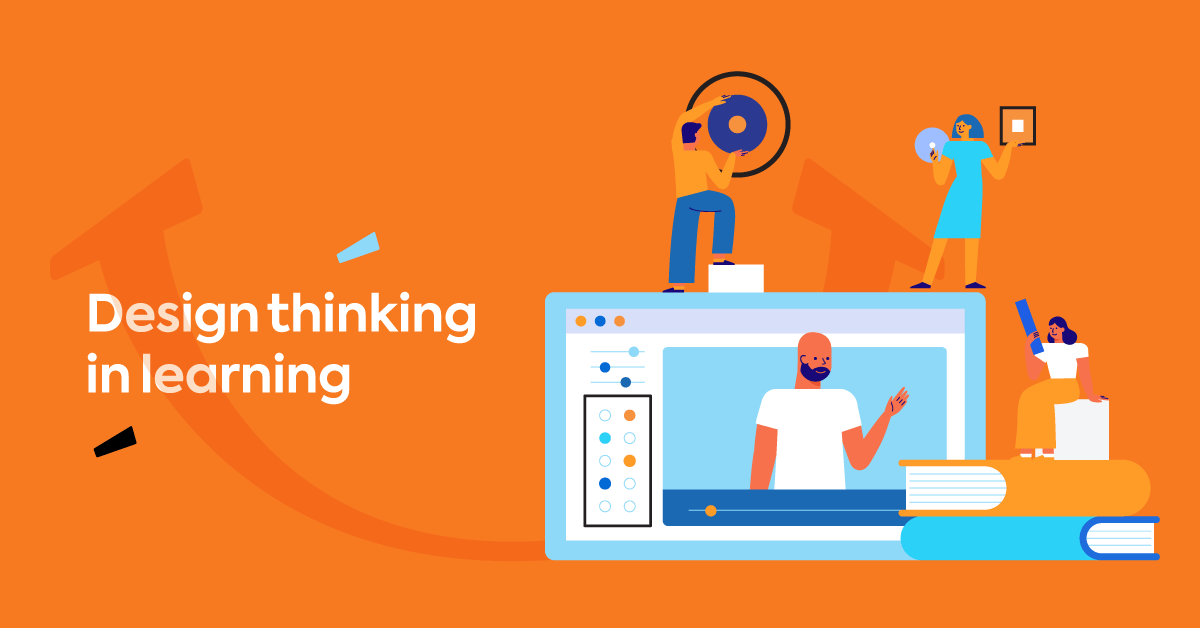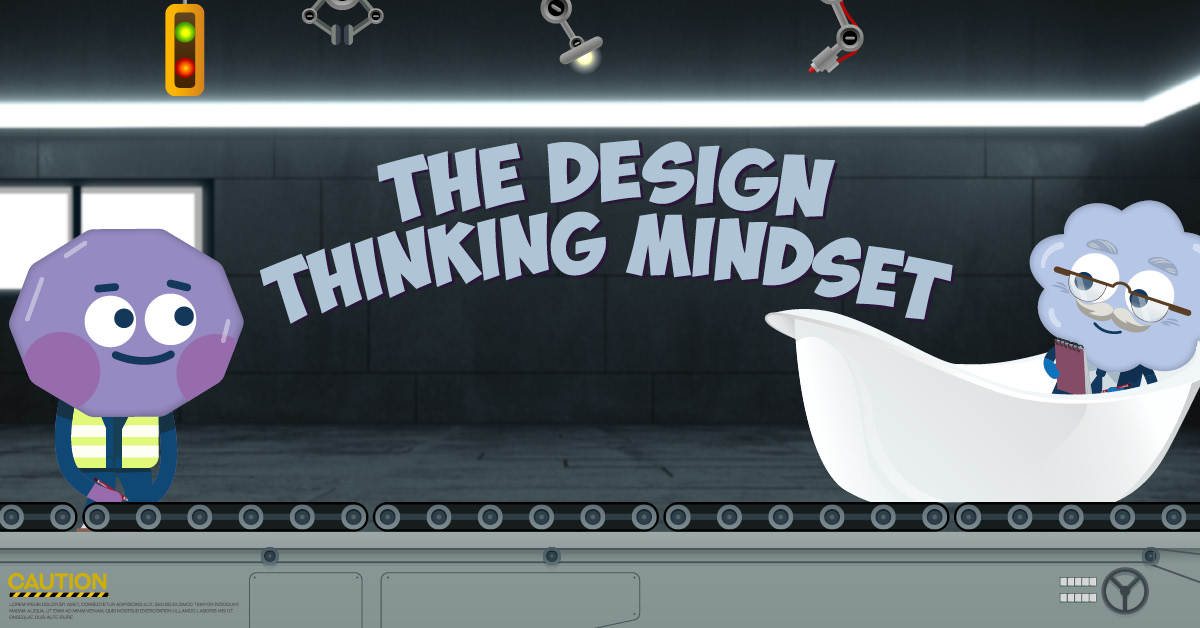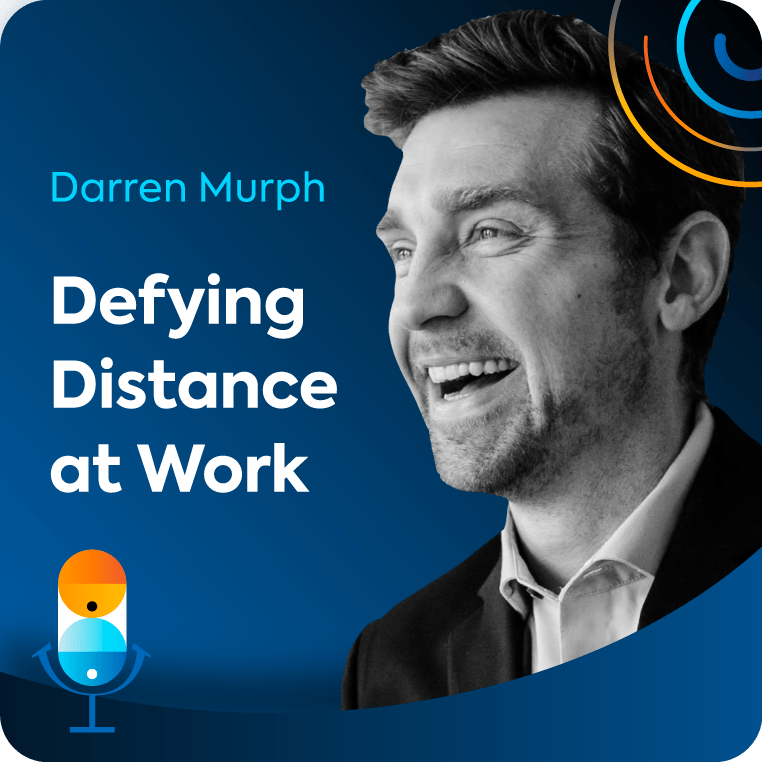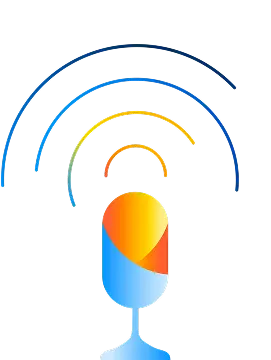Duration: 30 minutes
Season 1
Episode 4
Design thinking in the workplace
Is Design Thinking key to innovative ideas and solutions at work? What does empathy have to do with creative problem-solving? And can thinking visually help us communicate well with our colleagues? We’re talking to Karen Hold, co-author of “Experiencing Design: The Innovator’s Journey”.
Hold is the CEO and founder of Experience Labs, the innovation strategy consulting firm that’s advised the likes of Deloitte, Tik Tok, and Audi. Together, we’ll explore the need to embrace the ambiguity of problems, the four big questions, and how data-driven decisions don’t always pay off.

Key takeaways:
There are five skills that set the foundation before even attempting to using a design thinking toolkit. Relationship, scientific reasoning, presencing, opportunity seeking, and reflection skills. With these in mind, there are four big questions to ask and explore before getting to a final solution: What is the current status quo? What could we create if anything were possible? What wows? What works?
Empathy is the centre of design thinking. Empathy requires people to move from a self-focused, self-orienting, and self-centering place to another one where they’re other-centred. And in this place, people give others the benefit of the doubt when it comes to having a different set of experiences.
Most firms are risk averse. They don’t want to be wrong. But introducing experimentation and prototyping in large companies is extremely important. Design thinking is actually a great risk management strategy. It allows people to move down the risk curve with a set of activities that allow people to prototype and experiment. Taking a test and learn approach to discovering the way to success with small bets is better than making big investments that haven’t been de-risked and end up failing more often.
Design thinking is great for some problems. It’s a mistake to apply it to every problem. If there’s a known problem with a known solution, design thinking won’t be effective. But it’s ideal for complex problems, as it helps understand what the value chain is, immerses into the stakeholders to understand their needs, and make sure that the problem is being solved the right way. In brief, design thinking is great for problems where there is no known data.
There are different innovation personas (DISC) which show up for innovation differently. Drivers, for instance, typically like to do things by themselves. But there are three other personality times that work differently. The great thing about knowing how people show up at work and how they interact with others, allows us to leverage all talents and collaborate better.
Organizations can reimagine their culture around how they work with design thinking. Mindsets and behaviors play a significant role in doing work in ways that build possibility rather than constraint. Often in large companies there are internal obstacles to building new products and entering new markets. But design thinking helps change how people identify these opportunities for action and how possibility is being built.

Karen Hold
About our guest:
Karen Hold is the founder and CEO of innovation strategy consulting firm, Experience Labs. A Procter & Gamble-trained brand marketer, Karen saw firsthand how P&G drove revenue and profit growth with innovation.
With over 25 years of experience, Karen has consulted for dozens of Fortune 500 companies including AT&T, Alcatel-Lucent, Audi, Mercedes, Deloitte, Logitech, and Porsche. She is passionate about building creative capacity in individuals, organizations, and cities.
Share episode
Want more resources on this topic?

Design thinking for training and development

Design thinking in learning: A paradigm shift

TalentLibrary course: The design thinking mindset
More episodes we think you’ll love

How can we make sure employees are active and engaged during training? It’s time to elevate our learning game. We talk with Karl Kapp, Gamification and Instructional Design expert, professor at Bloomsburg University, and TEDx speaker.
Karl reveals the secrets behind crafting effective, meaningful, and interactive content design for businesses big and small.
Go to episode
How can managers make sure their remote teams don’t just survive, but thrive? We sit down with Darren Murph who’s been preaching the benefits of borderless offices for almost two decades, earning him the moniker ‘Oracle of Remote Work’.
Together, we cover everything from the tools that improve async work to how workplace culture is teetering on the verge of a seismic shift.
Go to episode
How can autonomous squads and agile principles unleash the potential of our teams and help businesses scale? We chat to Henrik Kniberg, the coder-turned-consultant, who’s helped coach teams at Minecraft, Lego and Spotify.
Henrik talks through the concepts of Squads and Scrums, taking us behind the scenes of Spotify’s early days when the start-up dared to implement Agile strategies at scale.
Go to episode
Never miss an episode! Get every new drop right in your inbox
By clicking the Subscribe button, you accept and consent to receive the type of content mentioned above. Please review the TalentLMS Privacy Policy for further information.
Full Episode Transcript
Host: Hi, Karen. How are you?
Karen Hold: Good. How are you? [00:02:08]
Host: I’m good. Thank you. So before we jump into the nitty gritty of design thinking, I would like to just get a sense of what led you into this sphere. You mentioned that you used to be an educator and it sounds like you still are, but was it always something you’ve been passionate about? How did it sort of come about? [00:02:28]
Karen Hold: Well, it’s a little roundabout story. I think I’ve always been a design thinker. I just didn’t have vocabulary to name those mindsets and name those behaviors. I began my career at Procter & Gamble in the early 90s and I got an education in customer centricity when I was at P&G. [00:02:31]
P&G is so focused on serving the needs of their customers, and it literally inspires everything that we did as a brand. And then I left and my husband and I had our own business for 13 years. We had a publishing company for 13 years. And I took all that customer centricity with me as an entrepreneur because if you’re not serving your clients, then you’re going to go out of business. [00:02:57]
But at the same time, I married into a family of designers. And so in 2010, I think it was, I found a language of design thinking. I realized that the mindsets and the behaviors that I was learning through my new family and the work that we had done in telecom and technology was all centered around design. The rest is history. [00:03:31]
Host: I do want us to talk about how companies can apply design thinking a little later. But first, I’d like to get a better sense of how it works in practical terms when it comes to product design and get a clear understanding of its main principles. So could you take us through the simple process of what it is, what it looks like when it comes to designing a product? [00:03:57]
Karen Hold: So for me, the foundation of design is really a set of mindsets and behaviors and a set of skills. So there’s a practical toolkit for problem solving, which includes steps and best practices. But I like to take a step back and think about what are those mindsets and behaviors that are necessary to even do design well. [00:04:23]
And so my coauthors and I wrote a book two years ago called “Experiencing design: The innovator’s journey,” and we outline the mindsets and behaviors that are the foundation of doing design well. And we found a set of five skills that are really important to set the foundation before you even attempt to try and put a toolkit into place. [00:04:50]
And those five skills are relationship skills, scientific reasoning skills, presencing skills, opportunity seeking skills, and reflection skills. And then with those mindsets and behaviors in place, you can use a problem-solving toolkit like design thinking to solve problems. And so I like to think of the design thinking toolkit in terms of four big questions that we like to ask. [00:05:17]
What is the current status quo? What if anything were possible, what could we create? What wows? Meaning we have to have an idea has to solve both viability, desirability and scalability. And then what works; testing our ideas and putting them into the marketplace. And within all of those questions, there are a set of activities that can help you get to a final solution. [00:05:48]
So, for this first question of what is a lot of discovery, research, trying to understand your customer, immersing yourself in their current status quo and understanding what their current reality is, and we start really wide open thinking. And we close that question with a set of design criteria. If anything were possible, our solution would include these things. [00:06:17]
We take that into this next question of what if, and we do brainstorming and come up with ideas that might help us solve this problem, napkin pitches, concepts, and we end with a set of a portfolio of options that can help us solve that particular problem. And then moving into what wows, we begin to think, okay, well, what does this idea look like? [00:06:47]
And we do prototyping and begin to do some co-creation, sharing that work with others. And then finally, what works, we run experiments and run tests to find out if our assumptions are true. And then prepare them for their first on ramp. [00:07:15]
Host: Great. And you’ve also talked before about design thinking being a non-linear way of thinking, correct? [00:07:33]
Karen Hold: Right, right.
Host: So can you also give us some practical examples of what these ways of thinking are? How they differ from more traditional linear forms of ideation? [00:07:39]
Karen Hold: Visualization, I think, is one of the most important techniques in prototyping. And then I’d say immersion, discovery research. There’s a great story. [00:07:52]
What is the name of the firm? I think it’s Pfizer. So Pfizer was trying to understand how people were using their products that they have in the bathroom, like Listerine and so forth. And, and so went in and followed, you know, with their permission, followed people around to understand what their habits were when they use their products, you know, in the bathroom. [00:08:03]
And they found out that people who were using Listerine, you know, Listerine comes in those big 20 ounce bottles. And so when people were traveling, they would have to put them into small bottles or they would, have to kind of work around a fix cause they didn’t want to bring the full 20 ounce bottle with them. [00:08:29]
And so they re imagined Listerine as a travel product and a pocket product. And so now, so they created Listerine, I think it’s called pocket pals or I don’t know, pocket blistering pockets. They’re like these little thin strips that you can put in your mouth. And it turned out to be something like a 500 million dollar category just by simply following people around and watching their habits in the bathroom, finding out that there was a need, an unmet need that they could meet with a new product. And so re imagined how that product was used created a new category that was extremely successful for the firm. [00:08:49]
[00:09:32] Host: I do want us to discuss design thinking in the workplace. So beyond the product design, how can people apply design thinking in their organizations? What are some areas within an organization where this type of thinking can really make an impact and help our work thrive?
Karen Hold: Yes. So I think in my work, I’m helping large organizations really reimagine their culture around how they do work. And so again, these mindsets and behaviors are so important for doing work in ways that build possibility rather than lead with constraint. So often in large companies, there are a lot of internal obstacles to building new product and entering new markets. [00:09:52]
And so design thinking has a wonderful contribution to culture and culture building to reimagine how we identify opportunities for action. And how we build possibility. I think the default mechanism in large organizations is to identify a problem and then to go straight to a solution. And when doing that, we miss all the opportunities that are available to align on whether that’s even really the problem we should be solving in the first place, because in large corporate organizations we’re rewarded for solving problems quickly. [00:10:24]
We’re not rewarded for sitting in the ambiguity and the complexity, trying to understand what the real problem is. That’s a shift in mindset, right? From moving from a place where we’ve solved problems quickly because we’re professionally rewarded for being a problem solver to a place where we’re willing to say, You know what? We need to study this. We need to sit in the complexity and the ambiguity of this problem to better understand what the real problem is. And then find a solution that builds on possibility rather than finding the very first solution. [00:11:04]
And I think even introducing experimentation and prototyping into large corporate activities is extremely important. Most firms that I work with are risk averse. And so the notion of experimentation and allowing ourselves to be wrong in service of learning is uncomfortable for a lot of organizations. [00:11:48]
They don’t want to be wrong, but nobody wants to be wrong. But I think design thinking is really a risk management strategy because it allows the set of activities that allow us to prototype and to experiment, allow us to move down the risk curve so that we make small bets quickly, rather than large investments all at once. And those large investments that haven’t been de risked usually end up failing more often than if you take a test and learn approach to learning your way to success rather than making big bets. [00:12:17]
Host: That’s great. And what would you say are some common mistakes or misconceptions that businesses might often make when starting out to apply design thinking? [00:12:57]
Karen Hold: Well, I think some of the common mistakes are trying to apply it to every problem. Design thinking is great for some problems, but it doesn’t make any sense for other problems. You know, if you’re trying to fix a toilet, you don’t need to design think it, you just need to hire a plumber and help you fix the toilet, right? [00:13:07]
There’s a known problem and a known solution, but for problems that are complex, design thinking is great because you can understand what the value chain is and immerse yourself in the stakeholders to try and better understand what their needs are to make sure that we are solving the right problem. [00:13:28]
It’s great for problems where there is no known data. You know, if you’re creating a new product, you are living in the world of the future and past data will not help you create something new. And so design thinking is really great to help you think about designing. new products for the future where there’s not a lot of data available. [00:13:48]
And when I was at P& G, I worked on the Folgers coffee brand, which in the early nineties was the number one brand in America. Maxwell House was number two. Starbucks were close to a billion dollar brand. Starbucks was 165 million business in the Pacific Northwest. And the younger members of our brand team knew that there was something special about this coffee house experience that we should probably be responding to because we were the largest coffee brand. [00:14:14]
And, you know, we tried to get our senior executives to listen to us and to understand, but we relied on Nielsen syndicated data, which was quantitative data measures, upstores, mass merge, grocery stores and convenience stores. And Starbucks didn’t show up on any of that data because Starbucks was being sold through other channels. [00:14:44]
So our senior executives couldn’t see Starbucks in the data we use to make decisions, so they just didn’t think it existed. Well, we managed to get them to fly out to Seattle, which was the epicenter of Coffee House Coffee, drove around to 25 different coffee shops and came back to Cincinnati, our headquarters, and decided not to respond. So we had every, every opportunity to be successful in that market. But what was holding us back was our senior executives’ sureness about the correctness of their point of view about the world and their reliance on this quantitative data. And as design thinkers, we rely on qualitative data in addition to quantitative data. [00:15:08]
And the qualitative data was showing that customers really like this Starbucks coffee. And so fast forward 30 years, Starbucks is a 26 billion business. Folgers is a 2 billion business. And we missed the opportunity to do some initial testing and experimentation in that marketplace. And if we had been design thinkers in the early nineties, we would have said, you know what? [00:15:57]
This qualitative data is interesting. There is something to this coffeehouse experience that consumers are enjoying. We should experiment and we should test our way to success and see if there’s a place for us in this potential market. But instead we rejected qualitative data. We rejected any, any conversation because we were the coffee people and we were the experts. [00:16:25]
Host: I just want to take us back to the workplace and design thinking within that realm. So, as I see it, design thinking has a lot to do with empathy, which is a crucial part of HR. A necessary skill for HR employees. So, would it be a reach to say that design thinking can really benefit HR? And if so, what do you think that would look like? [00:16:52]
Karen Hold: Well, I think empathy is the center of design thinking. When you think about a behavior and a skill that is central to doing design well, empathy is right at the center of that. Empathy requires you to move from a place where you’re self-focused, self-orienting, self-centering to a place where you’re other-centered. [00:17:16]
And when you’re other-centered, it allows you to give others the benefit of the doubt that they are having the set of experiences that are different from your own. From an HR perspective, thinking about how we’re resourcing and managing teams, potentially, you know, some of the work that needs to get done within an organization needs to be resourced with diverse talent. [00:17:43]
And if we are building product design teams without employees who are concerned about the customer oriented towards solving the customer’s needs, then we’re building products that are like trophies. They’re beautifully designed. They might be engineered with perfect technology, but they’re not serving the needs of the customers that we’re trying to solve. [00:18:08]
Host: That’s great. Thank you. And in your book, you have a section called “Different strokes for different folks” where you talk about different innovation personas. Now, I had a look and I just sort of think I’m probably a driver and honestly, the challenges sort of narrowed it down for me and I was like, “Yep. Yep. That’s probably me. I’m actively working on those.” Can you talk a little bit about those personas and why differentiating them might be useful for managers? [00:18:44]
Karen Hold: Yes. So all of our research was based on the DISC profile. I’m sure a lot of HR managers are very familiar with the DISC profile and we thought it was really helpful for understanding how people show up for innovation. [00:19:16]
Because different personality types show up for innovation differently. Drivers, let’s see if I get this correct for you, drivers typically like to do things by themselves. They don’t like to wait for others because they have a really good idea of where they’re going and how they want to do it. And they don’t really want to wait for people who maybe need some time to catch up to where they are. [00:19:32]
And so there are three other personality types that show up to work differently. And so the great thing about knowing how we show up for work and how we interact with others allows us to leverage others’ talents and allow us to collaborate better because. [00:19:59]
We have to be able to work across that difference. We know that innovation, the best innovation is a product of collaboration. It’s usually not the product of a single genius. And so we included that in the book so that we could help people understand how they show up for innovation. And provide some encouragement to know that for some people that the work of sitting in that ambiguity upfront of trying to understand what a customer’s needs are is de energizing and can feel very uncomfortable. [00:20:26]
And we know that. So we wanted to share that to say. This is what your roller coaster ride is going to look like. You’re going to be very uncomfortable up front, but the world needs your testing and experimentation expertise. And if you’re not there on the back end of innovation, because you are so uncomfortable with the front end, then what will happen is these ideas will probably fail in the marketplace because we really need your skills. [00:21:05]
But know that the journey up front is not going to be very fun for you. So here’s some ways that we can encourage you to get more comfortable. I can’t remove the discomfort, but at least you’ll stay with us on the journey because we need your expertise when it comes to the later stage of building. [00:21:33]
Host: But, I mean, that’s the driver for pretty much anything that requires a little bit of change pushing us that, that discomfort. And you mentioned it before as well that, you need to sit with it a little bit to really identify the problem. When you’re really uncomfortable, that’s when you’re going to do something about it. And the innovation is a product of collaboration. I love that even though I’m a driver. [00:21:54]
Karen Hold: The world needs lots of drivers. [00:22:22]
Host: We need lots of drivers, but honestly, we need people to reign us in as well. And that really does lead to a sort of much later question I had, but I think it ties in great. Would you recommend training employees in design thinking principles, either during onboarding or as in ongoing skills development? And if so, how would you do that? [00:22:24]
Karen Hold: Yeah, that’s a great question. So I am a big fan of the model that the Ritz Carlton uses when they’re onboarding new employees. They spend the first three weeks getting new employees sort of, indoctrinated sounds like a bad word, but you know what I mean? Like just immersed into the Ritz Carlton culture. [00:22:57]
And I am a huge advocate of immersing new employees in the culture of how we do work, but that takes a huge commitment and a willingness to spend those those first couple of weeks helping to immerse people in culture. So I don’t find that a lot of companies are doing that now, are able to do that. [00:23:10]
So they’re using design thinking training as a way to do ongoing training. That my program is a multi-week program. It’s a 16-week program and employees carve out a certain amount of time that they can learn tools, learn new mindsets and behaviors and practice on a real project. I like that long-term opportunity because it allows for a lot of re-imagining and reflection that maybe a four-day program or a five-day program doesn’t often allow for. [00:23:37]
Because it’s really that shift in mindset that happens over time. And so I’m a big fan of those longer programs that allow for the reflection and and a real change to emerge in how people approach and do work. [00:24:15]
Host: It sounds great. And again, like very different to what most companies are doing now from startups to larger corporations. Do you think that this is something that needs a big investment on companies part to implement? [00:24:32]
Karen Hold: Well, I think it depends on the kind of impact that you want to have and are you purchasing something that’s outta the box? Are you trying to design something that’s custom for you? I think it really depends. I think it depends on the context. I think it depends on whether you’re trying to create awareness. Or whether you’re trying to see improvement in current behavior and whether you want it customized. For me, I think there’s a solution for every client and every budget. It depends on what I think your goals are. [00:25:14]
Host: That’s great. I would like to talk about learning and development, which is also something that TalentLMS is all about. So in terms of developing a training program, how might design thinking be impactful? [00:25:31]
Karen Hold: So again, for me, the foundation is really in mindset and behavior shifts. Because we have a traditional way of working that in many organizations can be siloed and design thinking gives you an opportunity to manage across that difference and work across those departments so that we can do work together. [00:25:46]
But that requires a mindset shift in how we work. And so a lot of the work that I am doing tis around helping organizations shift those mindsets and behaviors from being self-orienting, self-focusing. Even whole departments are self-orienting, self-focusing and move to a place where they are other-centered. [00:26:12]
How can I collaborate? How can I leverage the assets that we have in order to build new products together. And so that really begins with teaching the relationship skills that allow us to move from a place where we are wanting to be right to a place where we’re willing to be wrong in pursuit of learning and experimentation. [00:26:38]
You probably work with people that love to say no, because whenever you bring a new idea or a new program, it happens all the time, right? That won’t work because the problem with that is. And so it requires a mindset shift to move from a place where you say yes. It’s from no, because to a place where you say yes, and, but that’s all about leading with possibility rather than leading with constraints. [00:27:03]
And so the training that I do is really about helping to shift those mindsets and behaviors, but we do it in fun ways by applying it to real projects and allowing the safe space to practice new behaviors. [00:27:34]
Host: That’s amazing because at the end of the day, we really do learn better through practice by applying something. So that’s great. And one final question, because this has been such a great conversation. I’ve really enjoyed it. But we do have to wrap up. So in one sentence, how can we keep it simple when it comes to applying design thinking principles in our organization? [00:27:49]
Karen Hold: Test and learn your way to success. [00:28:18]
Host: Incredible. Karen, thanks so much for speaking to us today. [00:28:22]
Thanks for tuning in. In the next episode, we’re exploring the nonlinear career with thought leader and startup advisor, Rusty Rueff. You can find Keep It Simple on all podcast platforms. Be sure to subscribe so you don’t miss an episode. This episode of Keep It Simple was brought to you by TalentLMS, the training platform built for success and designed with simplicity in mind. For further resources on today’s topic, visit talentlms.com/podcast
Train your people. Measure results. Drive growth.
TalentLMS gives you the tools to supercharge every step of your training.

